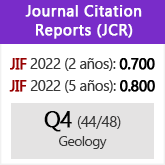Petrophysical characterization of the Dolomitic Member of the Boñar Formation (Upper Cretaceous; Duero Basin, Spain) as a potential CO2 reservoir
DOI:
https://doi.org/10.3989/egeol.42191.384Palabras clave:
CO2 storage, Upper Cretaceous, Boñar Formation, density, porosity, permeabilityResumen
Boñar Formation (Upper Cretaceous) is a mainly carbonate succession, which outcrops in the North of Duero Basin (Spain). According to the existing data, the Dolomitic Member of this formation appears to be the most suitable for geological storage of CO2. The main objective of this study is to find evidence to support, clarify and specify –at an initial level– the potential of the Dolomitic Member of the Boñar Formation as a geological reservoir. The study covers density, porosity and permeability tests on samples obtained from the outcrop of the succession near the village of Boñar (León). According to the analysis and interpretation of the mentioned petrophysical properties, the porosity of the Dolomitic Member is within the acceptable range for CO2 geological storage, but the permeability values are far too low. This minimizes the possibilities of the Dolomitic Member –and probably of the whole Boñar Formation– to become an appropriate CO2 reservoir.
Descargas
Citas
Chadwick, A.; Arts, R.; Bernstone, C.; May, F.; Thibeau, S. & Zweigel, P. (2008). Best practice for the storage of CO2 in saline aquifers - observations and guidelines from the SACS and CO2STORE projects. Nottingham: British Geological Survey, 267 pp. (British Geological Survey Occasional Publication, 14).
Evers, H.J. (1967). Geology of the Leonides between the Bernesga and Porma rivers, Cantabrian mountains, NW Spain. Leidse Geologische Mededelingen, 41 (1): 83–151.
García Lobón, J.L.; Reguera García, M.I.; Martín León, J.; Rey Moral, C. & Berrezueta Alvarado, E. (2010). Plan de selección y caracterización de áreas y estructuras favorables para el almacenamiento geológico de CO2 en España: resumen ejecutivo. Madrid: IGME, 75 pp.
Gómez-Fernández, F.; Bahamonde Rionda, J.R. & Méndez Cecilia, A. (2003). La Formación Bo-ar (Cretácico Superior, Norte de León): estratigrafía, geoquímica y potencial productor de roca ornamental. Revista de la Sociedad Geológica de España, 16: 61–71.
Hurtado Bezos, A. (2010). Metodología para la estimación regional de la capacidad de almacenamiento de CO2 en formaciones permeables profundas y sus incertidumbres. Tesis doctoral, Universidad de León, 404 pp.
International Energy Agency (2012). World energy outlook 2012. Paris, 668 pp.
International Energy Agency (2013). Technology roadmap: Carbon capture and storage. Paris, 59 pp.
Le Quéré, C.; Peters, G.P.; Andres, R.J.; Andrew, R.M.; Boden, T.; Ciais, P.; Friedlingstein, P.; Houghton, R.A.; Marland, G.; Moriarty, R.; Sitch, S.; Tans, P.; Arneth, A.; Arvanitis, A.; Bakker, D.C.E.; Bopp, L.; Canadell, J.G.; Chini, L.P.; Doney, S.C.; Harper, A.; Harris, I.; House, J.I.; Jain, A.K.; Jones, S.D.; Kato, E.; Keeling, R.F.; Klein Goldewijk, K.; Körtzinger, A.; Koven, C.; Lefèvre, N.; Omar, A.; Ono, T.; Park, G.H.; Pfeil, B.; Poulter, B.; Raupach, M.R.; Regnier, P.; Rödenbeck, C.; Saito, S.; Schwinger, J.; Segschneider, J.; Stocker, B.D.; Tilbrook, B.; Van Heuven, S.; Viovy, N.; Wanninkhof, R.; Wiltshire, A.; Zaehle, S. & Yue, C. (2013). Global carbon budget 2013. Earth System Science Data Discussions, 6 (2): 689–760. http://dx.doi.org/10.5194/essdd-6-689-2013
Lee, G.H.; Lee, B.; Kim, H.; Lee, K. & Park, M. (2014). The geological CO2 storage capacity of the Jeju Basin, offshore southern Korea, estimated using the storage efficiency. International Journal of Greenhouse Gas Control, 23: 22–29. http://dx.doi.org/10.1016/j.ijggc.2014.01.014
Lindholm, R.C. & Finkelman, R.B. (1972). Calcite staining: Semi-quantitative determination of ferrous iron. Journal of Sedimentary Petrology, 42 (1): 239–242. http://dx.doi.org/10.1306/74D724FA-2B21-11D7-8648000102C1865D
Llamas, B.; Álvarez, R.; Mazadiego, L.F.; Loredo, J. & Cámara, A. (2014). Estudio de afloramientos de unidades detríticas como posibles almacenes geológicos de CO2 en la Cuenca del Duero (España). Estudios Geológicos, 70 (1): e008. http://dx.doi.org/10.3989/egeol.41613.301
Metz, B.; Davidson, O.; De Coninck, H.; Loos, M. & Meyer, L. (2005). Carbon Dioxide Capture and Storage: Special Report of the Intergovernmental Panel on Climate Change. United Nations Environment Programme, 431 pp.
Tiab, D. & Donaldson, E. (2015). Chapter 3: Porosity and permeability. In: Petrophysics, 4th edition: Theory and Practice of Measuring Reservoir Rock and Fluid Transport Properties. Elsevier.
U.S. Department of Energy (2007). Carbon sequestration atlas of the United States and Canada. Office of Fossil Energy, National Energy Technology Laboratory, Morgantown, 90 pp.
Zapatero Rodríguez; M.Á.; Suárez Díaz, I.; Arenillas González, A.; Suárez Díaz, I.; Catalina Nita, R. & Martínez Orío, R. (2009). Proyecto Geocapacity: Estimación de la capacidad europea para el almacenamiento de CO2. Caso español. Madrid: IGME, 157 pp.
Publicado
Cómo citar
Número
Sección
Licencia
Derechos de autor 2016 Consejo Superior de Investigaciones Científicas (CSIC)

Esta obra está bajo una licencia internacional Creative Commons Atribución 4.0.
© CSIC. Los originales publicados en las ediciones impresa y electrónica de esta Revista son propiedad del Consejo Superior de Investigaciones Científicas, siendo necesario citar la procedencia en cualquier reproducción parcial o total.Salvo indicación contraria, todos los contenidos de la edición electrónica se distribuyen bajo una licencia de uso y distribución “Creative Commons Reconocimiento 4.0 Internacional ” (CC BY 4.0). Puede consultar desde aquí la versión informativa y el texto legal de la licencia. Esta circunstancia ha de hacerse constar expresamente de esta forma cuando sea necesario.
No se autoriza el depósito en repositorios, páginas web personales o similares de cualquier otra versión distinta a la publicada por el editor.

















